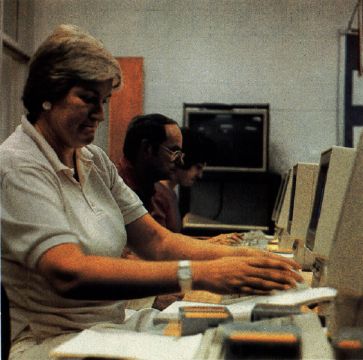
THE NEW SCHOOL
A MARYLAND HIGH SCHOOL PLUGS IN TO THE TWENTY-FIRST CENTURY
JEFF SLOAN
The tardy bell rings and the last of the stragglers wander into the largest of Quince Orchard High School's five computer labs. The early birds are already logged on to the 60 IBM Model 25s that line the tables. Through the school's Token Ring network, they can choose from programs like PageMaker, Microsoft Works, WordPerfect, and FoxBASE which reside in eight file servers located throughout the school. Applications that serve all of the school's 300 computers cover every subject from English and algebra to foreign language and social studies.
Today, the teacher is overseeing events as students manipulate spreadsheets and databases on their screens, performing the basic functions of accounting. Inside a classroom bordering the computer lab, a teacher boots up the roll-book program on his computer to take attendance before handing out the worksheets generated on his PC the day before. In another classroom on the opposite side of the lab, a teacher uses an LCD screen to project a lecture outline and other computer-generated images while students take notes.
Down the hall, in a resource center, a teacher uses a PC to mark her grade book, shuffle through assignments, make lesson plans, and tap the school's various teaching resources.
In the main office, the school's principal downloads student files from the district's mainframe computer for recordkeeping. In the guidance office, students use a PC to find the best sources for financial aid and to seek the college or career that best suits them.
This scenario remains a dream for many students and teachers, but at this Gaithersburg, Maryland, high school, the ideal is real. While the rest of the nation warns of technology antiquating the country's educational system, a little ingenuity in Gaithersburg has put the kids on the next bus for the twenty-first century.
"We wanted to give the kids access to the latest technology and prepare them for the world of computers," Principal Tom Warren says. But the computers are doing more than just preparing students for the future; they're changing the way students learn, think, and create.
The bigger question of whether computer technology is having a measurable effect on student scores remains unanswered. The system is still in its infancy and experiencing growing pains. But intangibles like attitude, creativity, ingenuity, and curiosity have improved, according to several teachers.
"I've noticed an improvement in attitude more than anything else," says John Brenneman, who teaches math and English at Quince Orchard and uses WordPerfect in his classes. Dick McCain, software coordinator and math and computer-programming teacher at Quince Orchard, has already noticed improvement in the way students manipulate math formulas. Gone are the days of plotting and plodding through graphs. McCain tells a story of the day he used the computers to introduce his students to simple algebraic graphing. By the end of the day, they were tracing parabolas and creating circles by adjusting variables in standard equations—not something McCain planned on.
"Students get more immediate recognition of concepts because of multigraphing," McCain says. "Experimentation on the part of the student is much greater. I think it's a confidence builder, too. They feel [that if] they can handle the computer, they can handle the subject as well."
|
The Teacher's Desktop This past July, the NEA's Committee on Educational Technology issued its report calling on all schools to implement a program to install a computer with adequate software on every teacher's desk by 1991. The goal of the recommendation is twofold: Use the computer to ease the burden of nonteaching paperwork duties, which consume up to 40 percent of a teacher's time; and promote the integration of technology with teaching to facilitate experiential learning and prepare students for today's advanced technology. Gary Watts, assistant executive director for professional and organizational development at NEA, says he doesn't think the 1991 deadline will be met. But he's encouraged by greater efforts to draw the computer into the classroom and thinks Quince Orchard High School is the system of the future. "You make teachers computer-using people, and then they become computer-using teachers," he says. Alan November, computer applications specialist for the Wellesley Public Schools in Wellesley, Massachusetts, claims that the way education deals with technology will affect how we live in the future. "If we don't do it, maintaining our current lifestyle is not feasible," he says. "It is essential that we have a technologically literate student population." Bob Pearlman, national consultant on educational technology for the American Federation of Teachers, insists that asking for a computer on every teacher's desk isn't the final solution. "There should be some things to facilitate those people who want them," he says. "What I would do is put that money out there for people who have interesting and innovative ideas. There aren't enough funds anywhere to do everything anyway." Judah Schwartz, professor of education at Harvard University, echoed those ideas, downplaying the role of the computer itself. Such variables as software and subject application determine the necessity of the computer, and it's a matter of finding the appropriate tools, he says. But November says the report isn't just a call for a computer for every teacher. It's asking for changes in the way education views and uses technology as a whole. "The report does not need to be adopted piecemeal," he says. "It really makes cultural suggestions, not just technological ones." Watts says one of the purposes of the recommendation is to redirect computer attention back toward the teacher. "The focus has been too much on the tool for the student, at the expense of the tool for the teacher," he says. "If it becomes a tool for the teacher, it will increase the amount of attention as a use for the student. One leads to the other." November claims the problem with computers in education became apparent when students came to class better technologically educated than their teachers. "That was the biggest single mistake nationally, not giving computers to the teachers first," he says. |
Jim Haber, who teaches computer programming at Springbrook High School in Montgomery County, says the computers foster a different kind of learning interaction. "We teach a way to think," he says. "When the students get to solving the problem, it's a fun atmosphere. You've got to make it the fun place to be."
Quince Orchard opened in September 1988 at a cost of $26 million. The 706,000 taxpayers in this affluent county north of Washington have a median income over $45,000. They expect a lot for what they pay, and they get it here. "It isn't cheap to do," agrees Warren.
Five labs, each with 30 computers, serve 1700 students with software in almost every discipline. With a ratio of about 1 computer for every 10 students, Quince Orchard easily bests the national average of 1 computer to 30 students. In addition, more than 150 computers are available to the staff. The 300 PS/2s are wired with Token Ring, linking every department, teacher, student, and administrator in the school to file servers. All about the school, visible wiring conduits stand out on the walls—testimony of the installation's newness.
The use of IBM equipment was a last-minute decision for the school, which had been designed with Apple computers in mind. About a year before the school opened, Warren and the Montgomery County Public Schools office of Computer Related Instruction (CRI) decided to go beyond the typical school computer configuration. "IBM just has more experience when it comes to networks," Warren says. "We needed that guarantee behind us to make this work."
Within a few months of installation, Quince Orchard staff and students were enjoying the modern luxuries of computing. In the library, students can access CompuServe, Dialog, and the card catalogs at the Montgomery County and the University of Maryland libraries. They can also peruse thousands of publications on CD-ROM discs. Students who have a PC and modem at home have remote access to the library—the ultimate homework source.
The school's computer system is linked to the county's mainframe computer through an Irma board, which lets a PC emulate a mainframe terminal. With this connection, administration personnel can download student records into school files. Although this system's password protection isn't the best security, administrators say too much security only challenges student hackers.
Quince Orchard's math/computer-science lab houses 60 personal computers.
Of the five student labs, the math/computer-science lab is the largest with 60 computers. A temporary divider in the middle of the room easily creates two 30-computer labs. Flanking the long room on each end are two glass-enclosed classrooms, which add to the class/lab atmosphere. Having learned concepts and theory in the classroom, students can move to the lab for hands-on experimentation and learning.
Darlene Grantham gives Richard Metcalfe and Sandra Metcalfe instructions in computer use.
Students and teachers all use dual-floppy IBM PS/2 Model 25s. Some administrators use Model 50s; the file servers are Model 80s. Students can choose from software in almost any educational category but must sign antipiracy contracts before beginning. They use one disk to access the network and another as a data disk. With increasing enrollment, Warren expects to increase the number of computers at the school to 350 and to add another lab within the next year.
Clearly the math and computer-science students get the most use out of the computers, but Beverly Sangston of CRI says the first priority is the teacher. "We wanted to be able to work with the teachers and show them what they can do, and then stand back and let them create," she says. "Number 1, we want to empower the teachers with the computer on their desks." Teachers at Quince Orchard are encouraged to take the their computers home during school breaks and holidays to increase use and familiarity.
"The idea was to give easy access to instructional and educational software," says Darlene Grantham, also of CRI. "The access they're getting to technology is just great. This school took risks."
Quince Orchard represents a county that understands how pivotal computers can be in education and that can afford the technology. For this school, the future of education is now. CRI's Grantham lightly taps the Model 25 screen in front of her. "They're not going away," she says.
Jeff Sloan is a journalism student at Colorado State University who worked at COMPUTE! as an editorial intern.